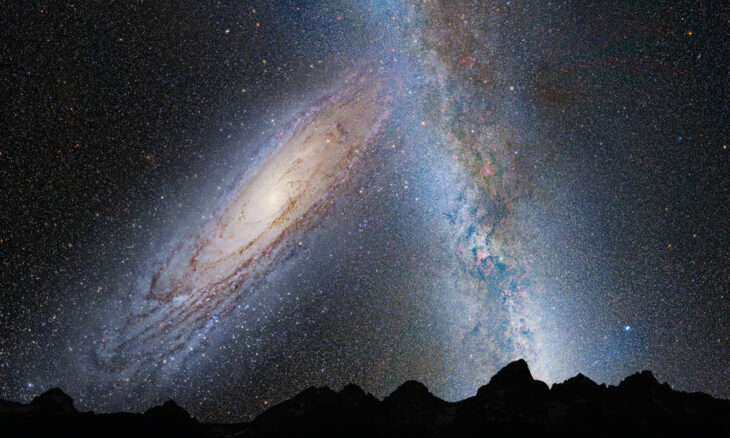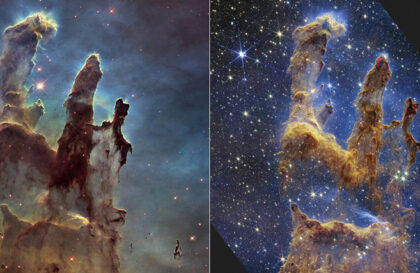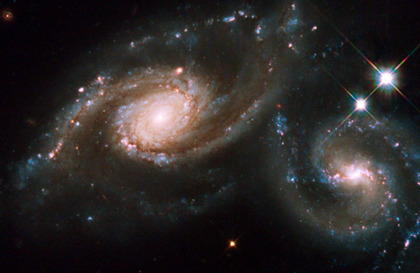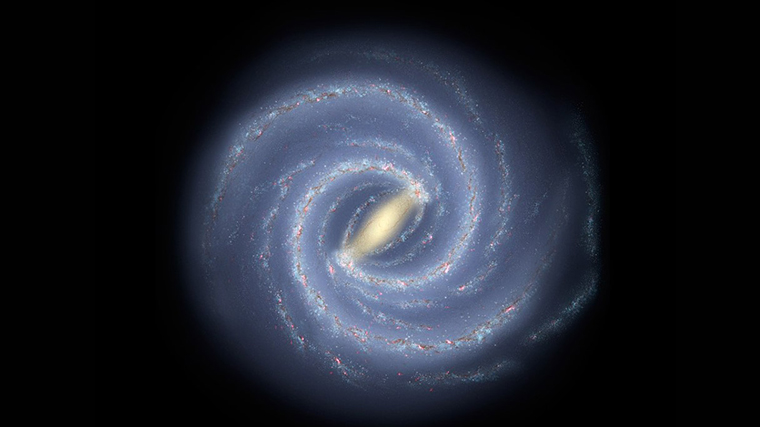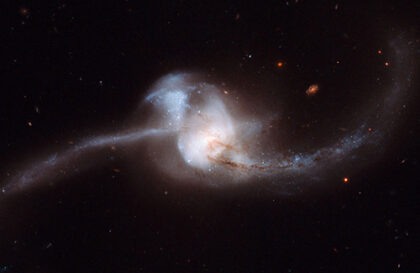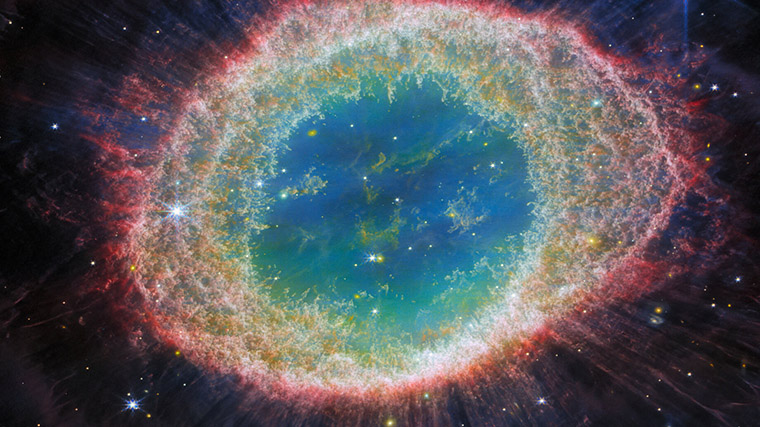Andromeda’s Past Collisions
It is believed that Andromeda formed about 10 billion years ago as a result of the merger of several smaller galaxies.
Eight billion years ago, Andromeda collided with another galaxy, triggering intense star formation and turning it into a bright infrared galaxy for the next 100 million years.
Roughly 210 million years ago, Andromeda and its smaller neighbor, galaxy M32, had an almost direct collision. This led to the disruption of Andromeda’s orderly spiral arm structure and the formation of two gas rings. M32 lost a large portion of its mass.
One hundred million years ago, Andromeda annexed a small galaxy, resulting in the creation of a gas disk rotating in the opposite direction of Andromeda’s rotation.
Victims of the Milky Way
Credit: ESA/Hubble & NASA, Dark Energy Survey/DOE/FNAL/DECam/CTIO/NOIRLab/NSF/AURA, J. Dalcanton; CC BY 4.0
The dwarf galaxy in the constellation of Canis Major is the closest to the Milky Way among our galactic neighbors: its distance from the Solar System is 25,000 light-years, and from the center of the Milky Way, it’s 42,000 light-years. Its stellar structure is being torn apart due to the gravitational influence of the Milky Way. Its core has regressed in its evolutionary development, and its stars have stretched into a chain-like formation that has wrapped around the Milky Way three times. This phenomenon is known as the “Monoceros Ring.”
The star stream in the constellation Virgo, discovered in 2005, is the remnants of a dwarf galaxy absorbed by the Milky Way. This is all that remains of it.
The dwarf galaxy Omega Centauri also couldn’t withstand the gravitational pull of the Milky Way.
Over ten billion years ago, the Milky Way collided with a galaxy named Kraken. Later on, it merged with another large galaxy, Gaia-Enceladus, leading to the formation of its thick disk and a bulging structure. At the time of this merger, the size of Gaia-Enceladus was four times smaller than the Milky Way, which was considerably smaller than its current size.
The Milky Way has had at least a dozen collisions with other galactic entities. However, these encounters were unequal: the Milky Way, being more massive, assimilated most of the matter from smaller galaxies.
In the plans for our galaxy is another grand phase – a merger with Andromeda. In 4 billion years, the Milky Way plans to “digest” the Large and Small Magellanic Clouds, as well as Andromeda’s satellite galaxy, M33. The chances of the Milky Way increasing its mass from these entities are estimated at 9%.
These upcoming events can be seen as a preparation for a galactic clash of titans.
Rival Profile
Andromeda
is a spiral galaxy located in the constellation of the same name. It is considerably more significant than the Milky Way—its diameter is almost twice as large, and the number of stars surpasses the number in our galaxy. Despite this, its total mass is lower than the Milky Way’s. It is located about 800 kiloparsecs away.
Credit: Corbis Documentary
The stars in Andromeda, on average, are older and contain more metals than the stars in the Milky Way. This galaxy has many satellite galaxies that influence its geometry. It has also had several interactions with other galaxies in its history.
Within a radius of 100 kiloparsecs from its center, there’s a mass estimated to be between 0.8 and 1.5 x 10^12 solar masses. The galaxy hosts approximately one trillion stars and has an unusual double nucleus. Stars are concentrated in each of these two cores, separated by a distance of 5 light-years. One of these nuclei contains a supermassive black hole weighing 50 million solar masses.
Furthermore, 35 black holes have been detected in Andromeda, most commonly with masses ranging from 5 to 10 solar masses, and it is home to a microquasar.
The Milky Way
is the galaxy that houses our Earth and Solar System and all the stars visible without a telescope. It’s a spiral galaxy with a bar and contains between 200 and 400 billion stars. Despite having fewer stars compared to Andromeda, the mass of the Milky Way within a radius of 129,000 light-years from its center is about 1.5 x 10^12 solar masses.
Interestingly, most of this mass is attributed to dark matter, not stars and gas.
At the very center of the Milky Way is a supermassive black hole named Sagittarius A*, with a mass of about 4.3 million solar masses. Nearby, it’s believed there’s a medium-sized black hole with a mass ranging from 1,000 to 10,000 solar masses and a rotation period of around 100 years.
Moreover, the galaxy is home to between 10 and 20 thousand relatively small black holes.
Andromeda and the Milky Way are Colliding
Credits: NASA; ESA; A. Feild and R. van der Marel, STScI
In about 4.5 billion years, the Milky Way and Andromeda will collide, and it will be a significant merger as the sizes of these galaxies are roughly comparable. Astronomers made this announcement in 2012. The merger will likely result in an elliptical galaxy or even a quasar, along with a new supermassive black hole and a “fireworks” of new star formation. The outcome of this cosmic event will largely depend on the details of the collision.
The Sun and other stars will remain untouched; the titanic chaos will likely push the Solar System to the outskirts of the merged galaxies. The collision between the Milky Way and Andromeda will almost certainly move the Sun outward from its current position 8,000 parsecs (26,000 light-years), from the center of the Galaxy. Simulations show a 10% chance that the Solar System will be exiled to the Galactic Siberia, more than 50,000 parsecs (160,000 light-years) from the center of the merged entities.
Credits: NASA; ESA; Z. Levay and R. van der Marel, STScI; T. Hallas, and A. Mellinger
After analyzing data collected by the Hubble Space Telescope from 2002 to 2010, researchers refined the motion of the Andromeda galaxy, which is located about 2.5 million light-years or 770,000 parsecs from Earth. This galaxy is our closest major spiral neighbor.
For many decades, scientists have known that Andromeda is approaching the Milky Way at a speed of 110 km/s. However, because the galaxy’s speed was measured primarily along the line of sight from Earth, there was no certainty about how exactly their future encounter would occur – whether it would be a major merger, a minimal approach, or something like a glancing contact.
The precision of the Hubble telescope in measuring the transverse motion of 15,000 stars in various regions of Andromeda allowed researchers to identify missing aspects of its movement. Robert van der Marel and his colleagues found that Andromeda’s lateral speed is much less than its speed along the line of sight, making their future merger with the Milky Way inevitable. They will fully merge four billion years from now and another two billion years later, forming a single galactic structure.
Darling and his research group are now applying an alternative method to determine the lateral movement of the Andromeda galaxy. They monitor the location of several water masers in the galaxy, which they have discovered. These masers are sources of strong radio emission and are associated with star formation processes. Darling and his colleagues expect to obtain more accurate data on this issue within the next two years.
According to forecasts, the stars and gas clouds of the Andromeda galaxy will become visible for observation without a telescope in about 3 billion years. After the collision, which will occur over 1-2 billion years, both galaxies will merge into one massive elliptical structure. Various names are proposed for this cosmic titan, for instance, “Milkomeda”. The graceful Milky Way will transform into a sort of star dump consisting of red, white, and yellow dwarfs and red giants, which will be much less interesting to study.
What will happen to Earth?
Before considering the possible outcomes of the collision of galaxies, it’s interesting to focus on the position of the Solar System within the Milky Way.
Position of the Sun in the Galaxy
The Sun is located approximately 27,000 ± 1,400 light-years from the center of the galaxy and about 35,000 light-years from its bar. This indicates that our star is situated closer to the periphery galaxies and will intersect fourf the galactic disk rather than its core. The Sun, along with other stars, orbits around the galactic center, where the supermassive black hole Sagittarius A* resides, at a speed of about 220-240 km/s, completing a full rotation approximately every 200 million years. It has made this rotation no more than 30 times throughout Earth’s existence.
Our star is roughly halfway between the two major spiral arms of the Milky Way — the Sagittarius arm and the Perseus arm. These arms are characterized by a 2-5 times higher concentration of gas and dust than the surrounding space and a two times higher concentration of young stars. The Sun is also located in the corotation circle, where the rotation speeds of stars and the density waves of the arms coincide. This circumstance is extremely important for Earth, as intense astrophysical processes occur in the spiral arms, which can be dangerous for living organisms. Perhaps, thanks to our planet’s “calm” position, life on Earth not only emerged but also managed to withstand cosmic threats over billions of years.
What will happen to Earth after the collision?
As a result of the collision, the Solar System may move from a tranquil lagoon to the epicenter of a galactic storm.
Credit & Copyright: Adam Block and Tim Puckett
Scientific Prediction
However, according to the most likely scientific forecast, the physical manifestations of this cosmic event will unfold so slowly (over hundreds of millions of years) that they might remain unnoticed by observers on Earth. Mostly, galaxies are made up of empty space, so it would be more accurate to say that they “penetrate” each other rather than collide. The chances that the Sun or the planets of the Solar System will be subjected to any direct impact are minimal.
For illustration, consider this: if the size of the Sun were equivalent to a coin with a diameter of 2.5 cm, the nearest star to it, Proxima Centauri, would be positioned at a distance of 718 km. On such a scale, the width of the Milky Way would be around 30 million km. The average distance between stars remains vast, approximately 160 billion km. This can be likened to placing one tennis ball every 3.2 km. Consequently, the probability of the Sun colliding with another star is extremely low.
A 50 percent chance of moving away from the center
In the event of a low collision velocity, as is presumed for Andromeda and the Milky Way, both galaxies might lack the kinetic energy required to move apart again. This will likely result in their merging into a single, massive galaxy. Scientists have already pondered names for this future supergalaxy, with “Milkomeda” being one of them (other options include “Milky Almond”, “Milky Commode”, and “Milky Dromeda”).
Within this forecast, there’s approximately a 50% chance that the Solar System will be flung to a distance three times greater than its current distance from the galactic center. Being further away from the central black hole, conditions for the continuation of life may become more favorable.
Other Black Swan Scenarios:
- If the two galaxies merely touch each other at their edges, moving tangentially, this can trigger intense gravitational fluctuations. The force of these fluctuations might push the Solar System out of the gravitational field of the newly formed galaxy. In this case, the Solar System would become an intergalactic wanderer. According to current estimates, the probability of this scenario is around 12%.
This doesn’t directly threaten Earth, although one sad consequence could be the loss of our beautiful starry sky. As for intergalactic radiation, the sun’s magnetosphere might offer some protection against it.
- Estimates suggest that there’s only a 3% chance the Solar System will fall under the gravitational influence of Andromeda. If this occurs, our system might enter the orbital rotation of Andromeda’s spiral arms, which the Milky Way’s arms might join, or new ones may form.
Should this scenario transpire, Earth will regularly find itself in zones of galactic instability. Likely, humans wouldn’t be able to provide effective protection against intense cosmic radiation in these conditions.
It’s implied that during this interaction, both galaxies will exchange stars on their peripheries, including the potential transition of the Sun to Andromeda. The Milky Way, having a stronger gravitational field in this region, will be able to attract stars from Andromeda while at the same time losing some of its own, including the Sun.
- There’s a small chance that the Sun could be drawn into a spiral arm of one of the galaxies, allowing the Solar System to remain untouched. In this case, there’s a possibility that humanity could adapt to new but stable living conditions.
This could occur if a gravitational shock wave altered the Sun’s usual orbit, ejecting it from the “blue lagoon” and switching it to the gravitational influence of an arm comprised of dust and gas clouds. Such an outcome is possible under various galaxy interaction scenarios.
- The culmination of the galaxy merger will be forming a single supermassive black hole, which will initiate the emergence of a powerful quasar. This will lead to the instant annihilation of all living organisms within tens and hundreds of light years from this event.
Credit: Science Photo Library / Alamy Stock Photo
However, the chances of the Sun and Earth being absorbed by the black hole existing at the center of the Milky Way, with a mass of about 4 million suns, are extremely low. Despite its immense mass, its event horizon is small, only around 12 million kilometers. This is too small a target to hit accidentally. Most stars in the Milky Way are not at risk of approaching this black hole within a distance of less than several thousand light-years, equivalent to tens of quadrillions of kilometers. Thus, the Earth will likely remain, although possibly without any living beings on it.
This scenario is considered under the assumption that the speed of the galaxy merger will be greater than previously estimated.
- Under the conditions specified in point 4, the most likely outcome is a significant displacement of the Sun from its current position of 8,000 parsecs (26,000 light-years) from the center of the Milky Way. Simulations indicate a 10% chance that the Solar System will be thrown to a distance of more than 50,000 parsecs (160,000 light-years) from the nucleus of the new galaxy. At the same time, the supermassive black holes will continue their orbital motions around the new center.
Nevertheless, by the time of the galaxies’ merger, the evolution of the Sun will have a far greater impact on life on Earth. It’s expected that in 5-6 billion years, it will turn into a red giant, which will have much more significant consequences for our planet.
Banner image: Credits: NASA; ESA; Z. Levay and R. van der Marel, STScI; T. Hallas; and A. Mellinger
Image credit:
https://www.nasa.gov
https://www.esa.int
https://www.space.com
https://www.nasa.gov
https://apod.nasa.gov
https://www.nbcnews.com
